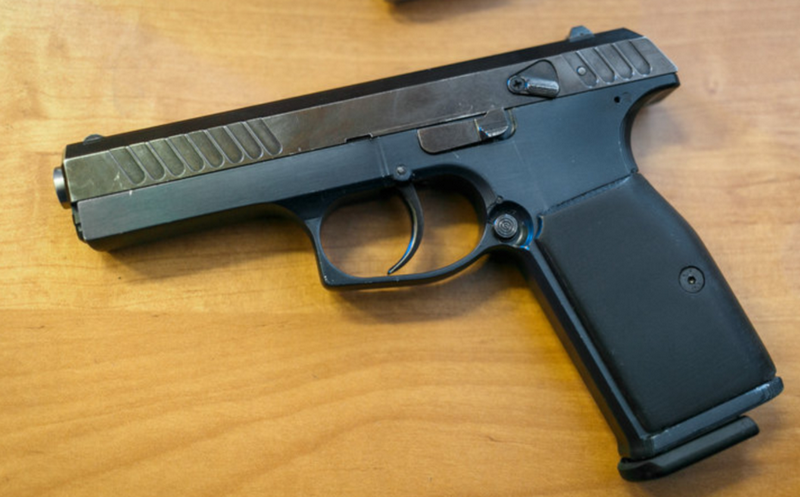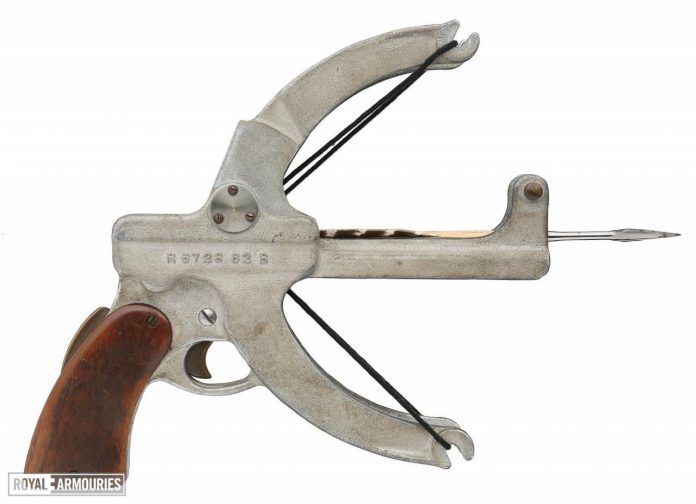
In the second half 1942 , the US Office of Strategic Services, Responsible for covert operations, began development of advanced models of silent small arms. We considered a variety of options such articles, including and not quite traditional. For example, in the shortest possible time Office of Strategic Services Specialists (US) We have developed a number of new crossbow, capable of hitting enemy manpower using a sharp arrow-bolts. The most compact representative of this product family was called Little Joe.
At that time, OSS staff have not yet decide on the ways of silent weapons, and to find the optimal design. In this regard, it developed as a parallel firearms, and thrown weapons. In the area of the last were studied several options for layout and design, Lets get different technical and operational capabilities. So, two new crossbows were made in the traditional form factor and had a folding stock, and the third was to be like a gun.
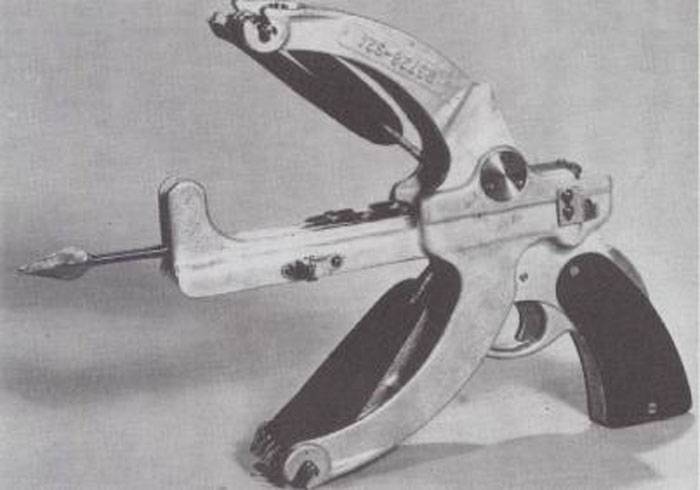 Little Joe crossbow cocked. photo Peashooter85.tumblr.com
Little Joe crossbow cocked. photo Peashooter85.tumblr.com
It should be recalled, that all the special design of projectile weapons from OSS designated as crossbows - «crossbow», but it did not meet this definition,. Energy storage, sending an arrow in flight, It proposed to use than traditional flexible shoulders bow, and a pair of rubber bands. In this way, In fact, these "crossbows" is a special version of the good old-fashioned slingshot, made using modern ideas and materials.
One of the new "slingshots" was smaller and different in its ergonomics - to some extent - match pistols. Such weapons have been developed in parallel with the other samples and, as they, received a specific name, hardly able to even hint at the essence of the project. Compact crossbow designated as Little Joe (also found writing Li'l Joe). The name "Little Joe" link this specimen with the larger Big Joe 5, but at the same time it maintains adequate privacy.
New Little Joe had to have a certain resemblance to a gun, however, it was disturbed by the presence of large protrusions, necessary to secure the rubber bands. Generally, he was like some fantastic weapon in the form of a trident with curved pistol grip. Unlike the two larger models, compact crossbow has vertically disposed arms, between which stretched rubber bands.
The largest and the main piece "Little Joe" was cast metal frame. Its shape is reminiscent of parts of revolvers, but it is very different from them. Its front part was made as a pair of curved longitudinal guides. Front guides were vertical to the protrusions, connected to a horizontal crosspiece. The main part of the frame is a sophisticated form, its lateral surfaces are located on different levels and joined smoothly with one another. In front of her departed guides, Rear was handle traditional curved revolvers.
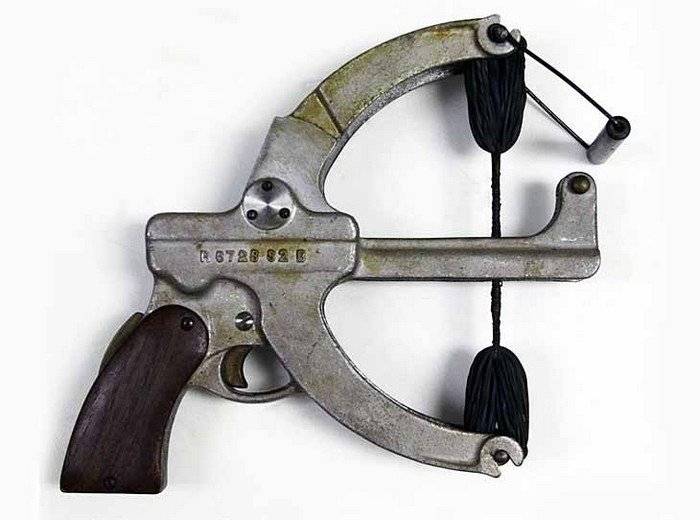 «little Joe» after several decades of storage. The weapon is equipped with a regular rubber bands. photo Reddit.com
«little Joe» after several decades of storage. The weapon is equipped with a regular rubber bands. photo Reddit.com
Directly designers put a large part to the trigger guard, performs the function of fixing one of the rubber bands. It was a curved tray U-shaped cross-section. Such a tray is retreated forwardly and downwardly relative to the frame. In its front wall portion form a pair of simple open hooks. Unlike traditional construction shoulder crossbow, detail of the "Little Joe" was tough and could not bend.
The main part of the frame had a deep notch. In the envisaged axis of the upper part of its sides to the rocker "shoulder" type lower. It also performed as a device with a U-shaped cross-section and a hook at the free end. At the bottom of this part we had holes for the axle. There is provided an extension to abut on the projections and the fixing frame in the operating position. Unlike the lower "shoulder", the top can be moved back and forth, that was used when reloading weapons.
Two pairs of hooks, located at the ends of "shoulders", intended for fastening two metal axles. On each axis installed freely rubber band, collected from a large number of individual rings. Also present on the wiring additional wire or textile ring, combine them into a single "string". Wire / yarn was in contact directly with arrow. Separate part-saddle to disperse the bolt was not provided.
Within the scope of OSS designers have placed a simple trigger. the shooting is controlled by a conventional trigger. Cocked mechanism holds the arrow in a starting position; when you press on the hook she was freed and was dispersed by means of harnesses. The mechanism cocked using large buttons, derived on the upper part of the frame. An interesting feature Little Joe crossbow pistol was the presence of Breaker. His key is located on the rear surface of the handle.
Together with the "Little Joe" uncharacteristic form factor was unusual sights. The presence of the upper "shoulder" excluded setting sight on the usual place, because of what he was carried to the left side frame. In the middle of the front guide the spring-loaded retractable front sight placed with a pair of circular bosses. In transport position, she turned back and placed on its base. The back of the frame was a fixed rear sight with V-Neck. The special shape of the front sight with a pair of bulges allowed to shoot at different ranges. However, it was only about a dozen meters.
In its ergonomics compact crossbow could resemble the various revolvers. Hold it offered for the curved handle. For added convenience, the metal piece frames were covered pair of wooden linings. Low weight allows to keep the weapon only by the handle, one or both hands.
According to some reports, crossbow Little Joe could be used two types of bolts. First boom performed only from metal, while the second wooden elements included. However, a significant difference in the design of the two arrows, allegedly intended for "Little Joe", suggests, this version does not correspond to reality. Wood-metal bolt, in contrast to the all-metal, I have means for interaction with a trigger mechanism.
Staff ammunition for a compact crossbow had a wooden shaft, which was worn on the front of a large and long tip. The latter had the phone for contact with a tree and pointed "Blade". On the staff includes four longitudinal slots, which is glued feathers. It is made of bird feathers. The tail end of the shaft has a small recess for interaction with "bowstring". There's also had a pair of curved metal hooks, by which an arrow held down the trigger.
Ready crossbow turns out not too many, especially in comparison with other designs of the time. The total length of the product - no more 10 inches with a height (in firing position) order 7-8 inches. Boom length - 8-10 inches. Due to the specific form of "Little Joe" could be carried only in a special holster, having a space for protruding parts.
Little Joe The product differs from other OSS development in many ways,, including the method of preparation for a shot. For pre-stretching rubber bands arrows had pull top "shoulder" up and back, against the stop. Pulling harnesses, This item is nearing its rearmost position, where the button is pressed the trigger cocking. At the same time it passes through the point of equilibrium, and now rubber rings, trying to shrink, We piled it back, preventing unwanted movement to the starting position.
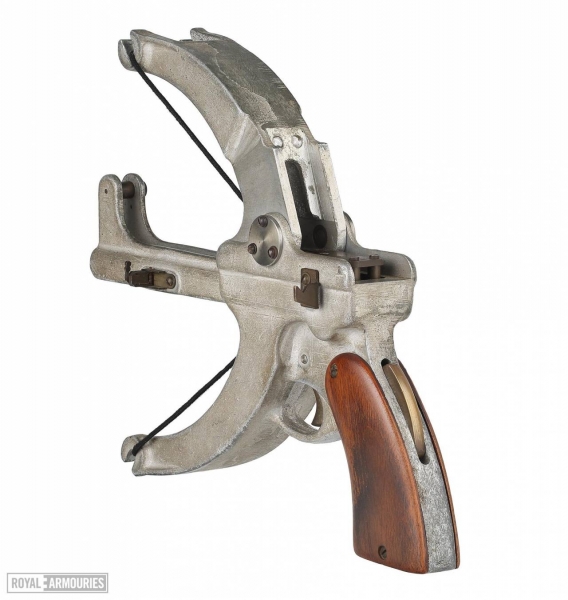 Left view from behind, crossbow is ready to fire. Photo Royal Armories UK / royalarmouries.org
Left view from behind, crossbow is ready to fire. Photo Royal Armories UK / royalarmouries.org
After bringing the weapon in such a position can be fitted an arrow. The arrow placed on the front longitudinal guide; its tip remained in front of the weapon, a shank included inside the frame. There, he hooks clinging to parts of the trigger mechanism. setting bolt, the shooter had to return to the upper arm to the starting position. moving forward, it was fixed in place by force harnesses. After that, you can aim and shoot.
To turn off the fuse should encircle the handle and to press the back button. This allowed us to pull the trigger and release the arrow. Further, rubber rings are contracted, and the boom dispersed along the guides. It can fire at a range of several tens of meters. At the same lethal effect on manpower remained at much smaller distances.
The known data, at the end 1942 , the Office of Strategic Services has produced several prototypes of prospective silent weapon. These products are intended for ground tests, the results of which are scheduled to take appropriate action. Upon receipt of OSS desired results could take crossbows adopted. However, not excluded and less optimistic starting. The thing is, that parallel created pistols and submachine guns with silencers devices, who had all the chances to get into the part and leave the throwing weapon without a job.
tests have shown, crossbows that all of the models do not have a significant advantage over the self-loading pistol with a silencer. They had a couple of advantages: such weapons have been significantly quieter, and could be used for different purposes boom. At the same time it can be awkward to transport and handle, It could make a few shots in a row without a lengthy and complex recharging, and also shows the relatively low quality of the fighting. Generally, firearms was much easier and more profitable throwing.
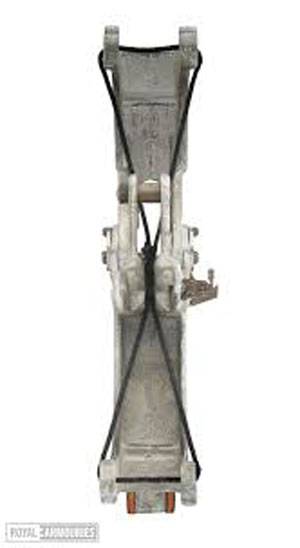 Front view. It is clearly seen and the location of the shoulder harness. Photo Royal Armories UK / royalarmouries.org
Front view. It is clearly seen and the location of the shoulder harness. Photo Royal Armories UK / royalarmouries.org
The history of the development of a number of crossbows options OSS ended almost immediately after the end of the test. Intelligence Agency has decided to equip its soldiers gunshot systems, equipped with a silencer devices. crossbows, in its turn, no special interest, and they were sent to storage. In the future, most of the assembled prototype was scrapped as unnecessary.
However, History Little Joe crossbow was a little longer. known, what in 1943 the American organization OSS handed, least, one such product with a stock of arrows British service Special Operations Executive. Special Operations Executive UK also needed in silent weapons, and expressed interest in US developments. In this way, a curious specimen of special weapons, rejected creators, could be used in another country.
It should be noted, that some sources mention the transfer of several samples of projectile weapons. according to them,, OSS SOE provided not only the "Little Joe", but also experienced the product type Big Joe 5 and, perhaps, William Tell. However, reliable data on this subject are available, and the transfer of Little Joe confirmed the known facts.
During the Second World War, the British security services have tested a wide variety of non-standard types of weapons, and many of them have been approved, and even recommendations for use in the actual operations. According to some reports, American crossbows were also recommended for use as an auxiliary weapon. With their help, assumed to run with the bolts or other equipment. Firstly, planned use of lamps or incendiary pyrotechnic compositions. The effectiveness of these arrows are not so strongly dependent on the characteristics of the crossbow, as is the case with the sharp martial bolts.
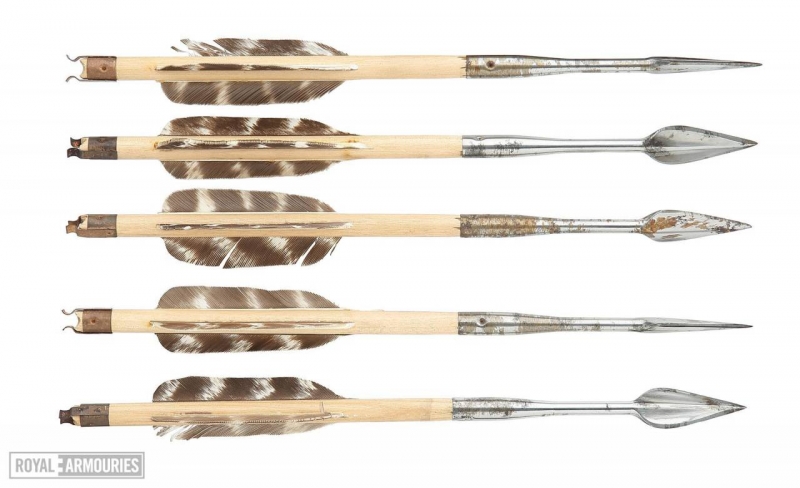 Arrows, found together with the museum Little Joe. Photo Royal Armories UK / royalarmouries.org
Arrows, found together with the museum Little Joe. Photo Royal Armories UK / royalarmouries.org
but, apparently, crossbows Little Joe - even if it came into operation in SOE units - not widely. Besides, there is no information on the use of such weapons in the actual operations. Quite possible, that such details until special operations to be disclosed, but do not rule out other options, in which arbalety simply not reached the battlefield.
Anyway, Battle Crossbow Little Joe the development of the American Office of Strategic Services is not widely used, and was not able to leave an imprint on the history of the Second World War. These weapons were fired at the minimum level and, probably, no one has been taken into service.
As far as, I lived up to our time only one example of the "Little Joe". Until recently, it was somewhere in the British army depots and remained in obscurity. AT 2005 , the Ministry of Defense has found a unique sample and handed it to the Royal Armory. At the crossbow passed several arrows mixed construction. After a small renovation and restoration of the appearance of the product has become a museum piece.
At the time of detection on metal parts and the transfer of the crossbow was attended by many oil stains. Besides, it were a rubber band axis. Currently, Little Joe is exposed with no harnesses and axes. Instead, they were placed on the arms of the elastic cord ring. This equipment allows us to understand the principles of operation of the product, although it does not illustrate them in full.
AT 1942-43 Years US Office of Strategic Services made several attempts to create a future combat crossbows for special forces. In all these projects,, generally, We managed to solve the engineering problems, but it was their only success. None of the samples, including Little Joe, not entered service. However, designers have yet to learn the original idea and made conclusions about its frailty. maybe, This was the main result of the program.
Based on materials:
— collections.royalarmouries.org/
— weaponsman.com/
— ww2f.com/
— peashooter85.tumblr.com/
— OSS Weapons: Special Weapons and Devices. Washington: Special weapons and devices research and development branch OSS, 1944.









